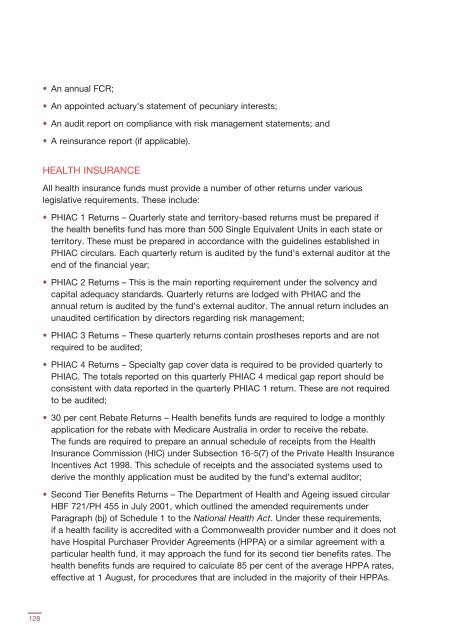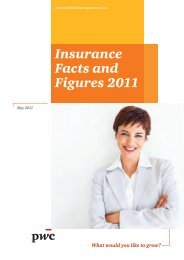Insurance facts and figures 2007 - PwC
Insurance facts and figures 2007 - PwC
Insurance facts and figures 2007 - PwC
You also want an ePaper? Increase the reach of your titles
YUMPU automatically turns print PDFs into web optimized ePapers that Google loves.
• An annual FCR;<br />
• An appointed actuary’s statement of pecuniary interests;<br />
• An audit report on compliance with risk management statements; <strong>and</strong><br />
• A reinsurance report (if applicable).<br />
HEALTH INSURANCE<br />
All health insurance funds must provide a number of other returns under various<br />
legislative requirements. These include:<br />
• PHIAC 1 Returns – Quarterly state <strong>and</strong> territory-based returns must be prepared if<br />
the health benefits fund has more than 500 Single Equivalent Units in each state or<br />
territory. These must be prepared in accordance with the guidelines established in<br />
PHIAC circulars. Each quarterly return is audited by the fund’s external auditor at the<br />
end of the financial year;<br />
• PHIAC 2 Returns – This is the main reporting requirement under the solvency <strong>and</strong><br />
capital adequacy st<strong>and</strong>ards. Quarterly returns are lodged with PHIAC <strong>and</strong> the<br />
annual return is audited by the fund’s external auditor. The annual return includes an<br />
unaudited certification by directors regarding risk management;<br />
• PHIAC 3 Returns – These quarterly returns contain prostheses reports <strong>and</strong> are not<br />
required to be audited;<br />
• PHIAC 4 Returns – Specialty gap cover data is required to be provided quarterly to<br />
PHIAC. The totals reported on this quarterly PHIAC 4 medical gap report should be<br />
consistent with data reported in the quarterly PHIAC 1 return. These are not required<br />
to be audited;<br />
• 30 per cent Rebate Returns – Health benefits funds are required to lodge a monthly<br />
application for the rebate with Medicare Australia in order to receive the rebate.<br />
The funds are required to prepare an annual schedule of receipts from the Health<br />
<strong>Insurance</strong> Commission (HIC) under Subsection 16-5(7) of the Private Health <strong>Insurance</strong><br />
Incentives Act 1998. This schedule of receipts <strong>and</strong> the associated systems used to<br />
derive the monthly application must be audited by the fund’s external auditor;<br />
• Second Tier Benefits Returns – The Department of Health <strong>and</strong> Ageing issued circular<br />
HBF 721/PH 455 in July 2001, which outlined the amended requirements under<br />
Paragraph (bj) of Schedule 1 to the National Health Act. Under these requirements,<br />
if a health facility is accredited with a Commonwealth provider number <strong>and</strong> it does not<br />
have Hospital Purchaser Provider Agreements (HPPA) or a similar agreement with a<br />
particular health fund, it may approach the fund for its second tier benefits rates. The<br />
health benefits funds are required to calculate 85 per cent of the average HPPA rates,<br />
effective at 1 August, for procedures that are included in the majority of their HPPAs.<br />
128
















